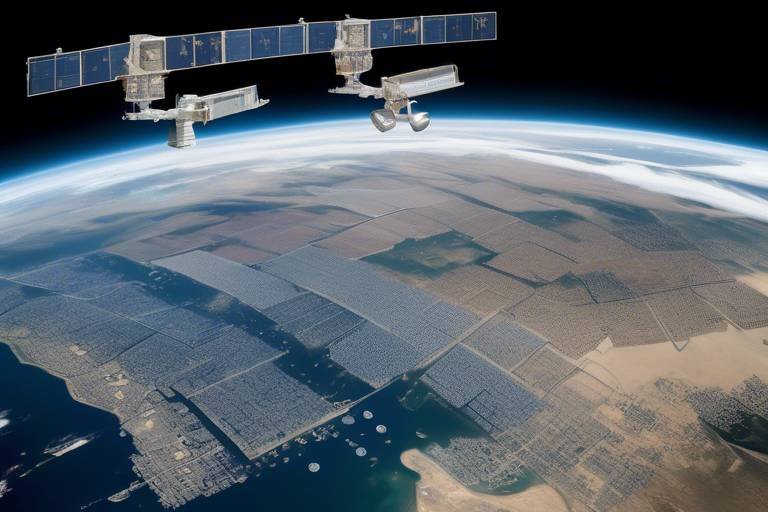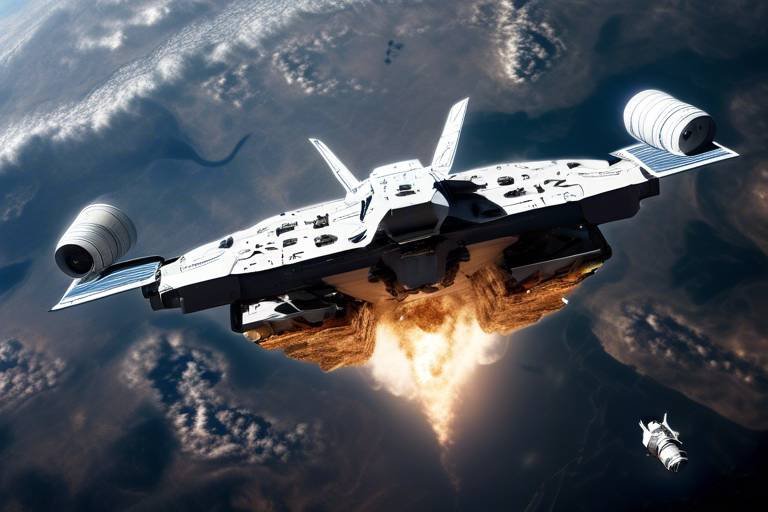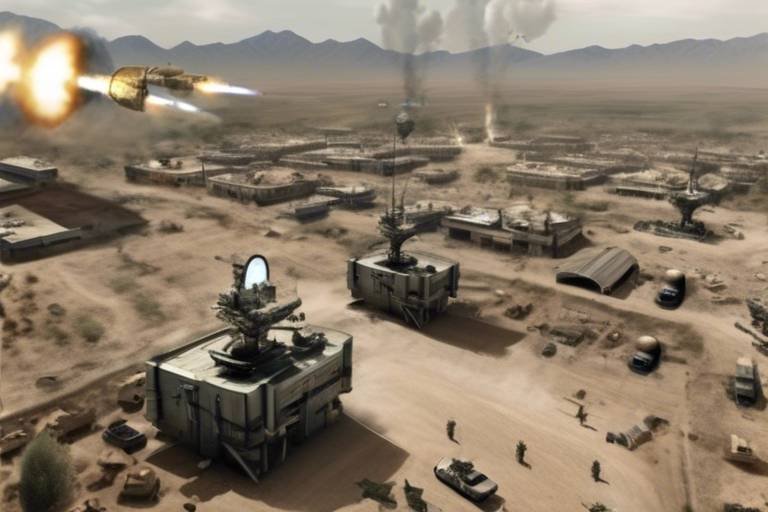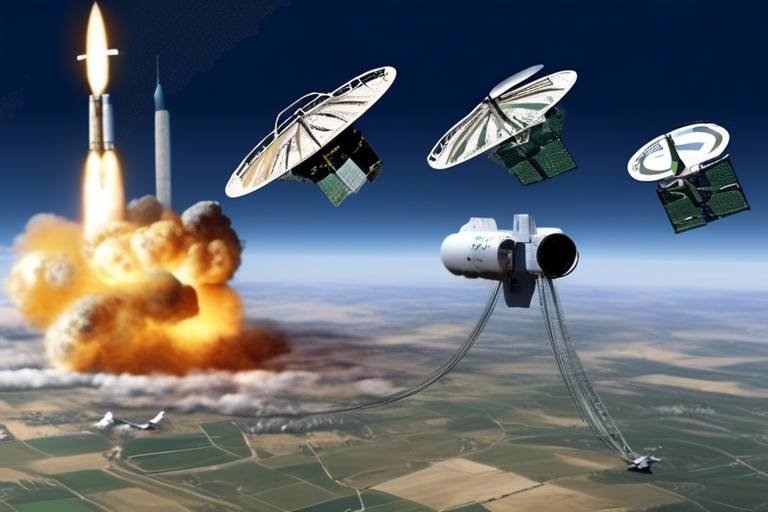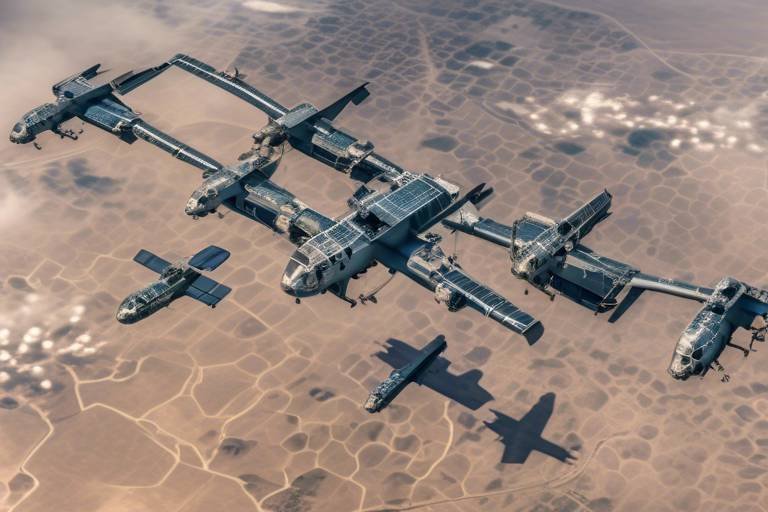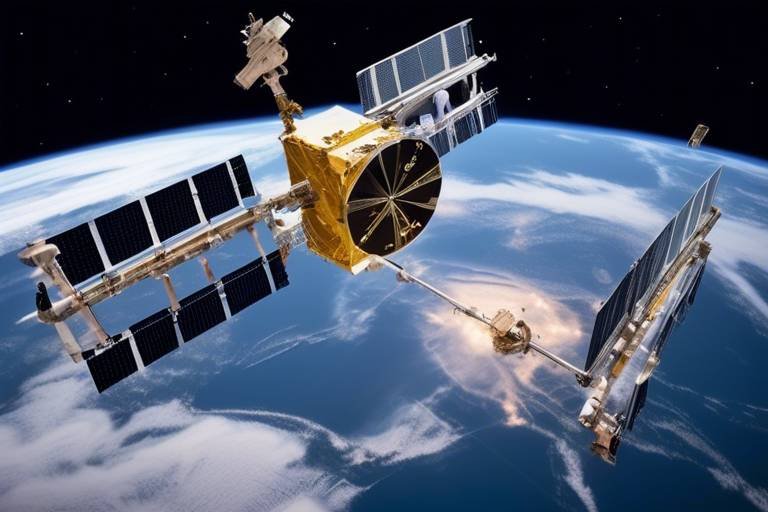The Evolution of Military Satellite Communication Networks
The realm of military operations has undergone a profound transformation over the decades, primarily driven by the evolution of satellite communication networks. These networks have become the backbone of modern warfare, providing unparalleled connectivity and enabling real-time decision-making in the field. Imagine a world where troops in remote locations can communicate instantly with command centers thousands of miles away—this is the power of military satellite communication.
From the early days of rudimentary satellite technology to today's sophisticated systems, military satellite communication has continually adapted to meet the growing demands of global security. The journey began in the late 1950s, with the launch of the first artificial satellites, which paved the way for military applications. The Cold War era marked a significant turning point, as nations raced to develop advanced satellite systems capable of supporting their military objectives.
As we delve deeper into the historical milestones of military satellite communication, we can see several key developments that have shaped its trajectory. The introduction of the Defense Satellite Communications System (DSCS) in the 1970s was a game changer, providing secure and reliable communication links for U.S. forces. Following this, the Wideband Global SATCOM (WGS) system emerged, offering high-capacity communication channels that enhanced operational efficiency and command capabilities.
Today, military satellite networks are not just about communication; they encompass a wide array of technologies that improve situational awareness, intelligence gathering, and operational coordination. With the integration of ground-based systems, military forces can achieve a level of synergy that significantly enhances their effectiveness in the field. This interconnectedness allows for a holistic approach to military strategy, where every piece of information is at the fingertips of decision-makers, ready to be acted upon in real time.
However, the evolution of military satellite communication is not without its challenges. As technology advances, so do the threats posed by adversaries. Cybersecurity concerns are paramount, as military networks must defend against potential breaches that could compromise sensitive information. Additionally, interference issues and the constant need for technological upgrades present ongoing hurdles for military communications.
Looking to the future, the potential for emerging technologies like artificial intelligence and quantum communication to revolutionize military satellite networks is immense. These innovations promise to enhance data transmission capabilities and security measures, ensuring that military forces remain one step ahead in an increasingly complex world. The evolution of military satellite communication is a testament to human ingenuity and the relentless pursuit of global security.
- What are military satellite communication networks?
Military satellite communication networks are systems that enable secure and reliable communication between military forces using satellites orbiting the Earth. - How have military satellite networks evolved over time?
They have evolved from basic communication systems in the 1960s to advanced networks capable of supporting real-time data sharing and operational coordination. - What are the main challenges faced by military satellite communication?
Challenges include cybersecurity threats, interference issues, and the need for constant technological upgrades to maintain security and effectiveness. - What is the future of military satellite communication?
The future may involve advancements in AI and quantum communication, which could further enhance data transmission capabilities and security.
Historical Milestones in Military Satellite Communication
The journey of military satellite communication has been nothing short of revolutionary, marked by pivotal milestones that have shaped the landscape of defense strategies globally. It all began in the early 1960s, when the world was engulfed in the Cold War—a period characterized by intense rivalry between superpowers. The launch of the first communication satellite, Telstar 1, in 1962, was a groundbreaking achievement that showcased the potential of satellites for real-time communication. This event not only set the stage for commercial satellite services but also sparked interest in military applications.
As the Cold War escalated, the U.S. military recognized the need for secure and reliable communication channels. The establishment of the Defense Satellite Communications System (DSCS) in the 1970s marked a significant turning point. This system was designed to provide secure, jam-resistant communication links for the U.S. Armed Forces, allowing them to maintain command and control during critical operations. With the DSCS, military leaders could communicate seamlessly, even in the most challenging environments, which proved essential during conflicts such as the Vietnam War.
The 1980s brought further advancements with the introduction of the Milstar satellite system, which enhanced the capabilities of military communication by incorporating advanced encryption techniques and improved data transmission rates. The Milstar satellites were designed to operate in a highly contested environment, ensuring that military communications remained secure and reliable, even when faced with potential adversaries.
Fast forward to the 1990s, and we see the dawn of the Wideband Global SATCOM (WGS) system. This system was a game changer, providing high-capacity communication links that allowed for real-time data sharing among military units. The WGS enabled forces to operate with enhanced situational awareness, facilitating better decision-making on the battlefield. The integration of these satellite systems into military operations demonstrated a significant leap in technology, providing unprecedented levels of connectivity and operational efficiency.
To summarize the historical milestones, let's take a look at the following table that highlights key developments in military satellite communication:
| Year | Milestone | Impact |
|---|---|---|
| 1962 | Launch of Telstar 1 | First commercial satellite; paved the way for military applications. |
| 1970s | Establishment of DSCS | Provided secure, jam-resistant communication for U.S. Armed Forces. |
| 1980s | Introduction of Milstar | Enhanced encryption and data transmission for secure military communication. |
| 1990s | Launch of WGS | High-capacity communication links for real-time data sharing. |
These milestones not only illustrate the evolution of military satellite communication but also highlight the continuous need for innovation in this field. As we look back at these significant events, it's clear that each step forward has been driven by the necessity for enhanced communication capabilities in an ever-changing global landscape. The advancements in satellite technology have not only improved military operations but have also played a crucial role in shaping global security dynamics.
Technological Advancements Over the Decades
The landscape of military satellite communication has undergone a **remarkable transformation** over the decades, driven by rapid advancements in technology. From the early days of rudimentary communication systems to today's sophisticated networks, the evolution of these technologies has played a crucial role in enhancing military operations. One of the most significant developments has been the **increase in bandwidth**, which has allowed for the transmission of larger amounts of data at much faster rates. This improvement has been essential for real-time communication, enabling troops to make informed decisions on the battlefield.
In addition to bandwidth improvements, **encryption technologies** have become increasingly sophisticated. As military operations often involve sensitive information, ensuring secure communication channels is paramount. The integration of advanced encryption techniques has made it significantly harder for adversaries to intercept and decode military communications. This focus on security has not only protected operational data but has also instilled confidence among military personnel in the reliability of their communication systems.
Another pivotal advancement has been in **data transmission capabilities**. The introduction of technologies such as **digital signal processing** and **error correction algorithms** has greatly enhanced the quality and reliability of satellite communications. These innovations have minimized the chances of data loss, ensuring that critical information reaches its destination without delay. In military operations, where every second counts, such advancements can be the difference between success and failure.
Moreover, the development of **multi-band satellites** has revolutionized military communication. These satellites can operate across various frequency bands, allowing for greater flexibility and efficiency in communication. This capability is particularly beneficial in joint operations where multiple branches of the military must coordinate seamlessly. By utilizing different frequency bands, military forces can avoid interference and ensure uninterrupted communication, even in the most challenging environments.
To illustrate the impact of these advancements, consider the following table that outlines key technological milestones in military satellite communication:
| Year | Advancement | Impact |
|---|---|---|
| 1960 | Launch of the first military satellite | Established the foundation for satellite communication |
| 1980 | Introduction of secure encryption | Enhanced data security for military communications |
| 2000 | Deployment of high-bandwidth satellites | Enabled real-time data sharing |
| 2010 | Implementation of multi-band technology | Improved operational flexibility and coordination |
| 2020 | Integration of AI in communication systems | Enhanced decision-making and predictive analytics |
As we look toward the future, the integration of **artificial intelligence (AI)** and **machine learning** into military satellite communication systems promises to further enhance operational capabilities. These technologies can analyze vast amounts of data in real-time, providing military leaders with actionable insights and improving overall situational awareness. The potential for **quantum communication** also looms on the horizon, offering unprecedented levels of security and speed that could redefine military communication strategies.
In conclusion, the **technological advancements** in military satellite communication over the decades have been nothing short of revolutionary. From increased bandwidth and enhanced encryption to the integration of AI, these innovations continue to shape the future of military operations. As technology evolves, so too will the strategies and capabilities of armed forces around the globe, ensuring they remain prepared for the challenges of tomorrow.
Key Satellite Programs
The landscape of military satellite communication is profoundly shaped by several key satellite programs that have paved the way for modern communication strategies. Among these, the Defense Satellite Communications System (DSCS) and the Wideband Global SATCOM (WGS) stand out as pivotal innovations. These programs not only enhanced communication capabilities but also redefined operational frameworks for military forces around the globe.
The Defense Satellite Communications System (DSCS) was a groundbreaking initiative that fundamentally changed the way military communications were conducted. Launched in the 1970s, DSCS provided secure and reliable communication links to U.S. military forces. Its robust architecture allowed for a variety of communication modes, including voice, data, and video transmissions. This versatility was crucial during critical military operations, particularly in the Cold War era, where secure communications were paramount. The system's ability to support multiple users simultaneously ensured that commanders on the ground could maintain constant contact with their operational bases, significantly enhancing situational awareness.
On the other hand, the Wideband Global SATCOM (WGS) system took military communication to the next level by expanding bandwidth capabilities. Introduced in the mid-2000s, WGS was designed to provide high-capacity communication links that were essential for modern military operations. With its ability to facilitate real-time data sharing, WGS greatly improved command and control capabilities, allowing military leaders to make informed decisions rapidly. The system also supports a wide array of communication applications, from intelligence gathering to logistical support, proving to be an invaluable asset in various theaters of operation.
Both DSCS and WGS exemplify how technological advancements can revolutionize military communication. They not only provide the infrastructure needed for effective communication but also enhance collaboration among different branches of the military. The integration of these systems with ground-based networks has further improved operational effectiveness, ensuring that troops on the ground receive timely information and support.
In summary, the evolution of military satellite communication programs like DSCS and WGS illustrates the increasing complexity and necessity of secure, reliable communication in military operations. As technology continues to advance, these programs will likely evolve further, adapting to meet the ever-changing demands of modern warfare.
- What is the primary purpose of military satellite communication?
Military satellite communication is primarily used to provide secure, reliable communication links for military operations, enabling real-time data sharing and coordination among forces. - How do DSCS and WGS differ?
DSCS focuses on secure communications with a robust architecture, while WGS emphasizes high-capacity links for real-time data sharing and enhanced operational capabilities. - What are the challenges faced by military satellite communication systems?
Challenges include cybersecurity threats, interference issues, and the need for constant technological upgrades to maintain security and efficiency.
DSCS: A Game Changer
The Defense Satellite Communications System (DSCS) has been a pivotal element in the evolution of military communications, fundamentally altering how armed forces operate. Launched during the Cold War, the DSCS was designed to provide the U.S. military with secure, reliable, and high-capacity communication capabilities. Imagine a vast web of interconnected satellites, each acting as a relay station, transmitting crucial information across the globe in real-time. This system was not just a technological marvel; it became the backbone of military operations, enabling commanders to make informed decisions swiftly and efficiently.
One of the standout features of the DSCS is its robust architecture. The system employs a combination of geostationary satellites and ground stations that work in perfect harmony, allowing for uninterrupted communication even in the most challenging environments. This capability was particularly crucial during conflicts where every second counted. The DSCS provided essential services, including voice communications, data transmission, and video conferencing, ensuring that military personnel could coordinate efforts seamlessly, regardless of their location.
Moreover, the DSCS was designed with security in mind. With the increasing threat of espionage and cyber attacks, the system incorporated advanced encryption techniques to safeguard sensitive information. This focus on security meant that even if adversaries attempted to intercept communications, the data would remain protected, thus maintaining operational integrity. The DSCS set a precedent for future satellite communication systems, emphasizing the importance of security in military operations.
As technology evolved, so did the capabilities of the DSCS. Over the years, various upgrades and enhancements were implemented, allowing the system to adapt to the changing landscape of military needs. For instance, the introduction of new satellites with improved bandwidth significantly increased the volume of data that could be transmitted, making real-time intelligence sharing a reality. This capability not only enhanced situational awareness but also allowed for more effective command and control, which is vital in modern warfare.
In summary, the DSCS has been a game changer in military satellite communications. Its ability to provide secure, reliable, and high-capacity communication has transformed how military operations are conducted. As we look to the future, the legacy of the DSCS will undoubtedly influence the development of next-generation communication systems, ensuring that military forces remain connected and capable in an ever-evolving global landscape.
- What is the primary function of the DSCS? The primary function of the DSCS is to provide secure and reliable military communication capabilities, including voice, data, and video services.
- How does the DSCS ensure security? The DSCS employs advanced encryption techniques to protect sensitive information from interception and cyber threats.
- What advancements have been made to the DSCS over the years? Over the years, the DSCS has undergone numerous upgrades, including the introduction of new satellites with enhanced bandwidth for better data transmission.
- Why is the DSCS considered a game changer? The DSCS is considered a game changer because it revolutionized military communications, enabling real-time coordination and decision-making, which is crucial in modern warfare.
WGS: Expanding Bandwidth
The Wideband Global SATCOM (WGS) system represents a significant leap forward in military satellite communication, primarily due to its ability to expand bandwidth dramatically. In a world where information is power, the capacity to transmit large volumes of data quickly and securely is essential for effective military operations. WGS provides the U.S. Armed Forces with high-capacity communication links that facilitate real-time data sharing, enhancing command and control capabilities across various military branches.
One of the standout features of WGS is its multi-band capabilities, which allow for simultaneous transmission across different frequency bands. This flexibility is crucial because it enables military personnel to adapt to varying operational requirements and environmental conditions. For instance, during a mission, the ability to switch between X-band and Ka-band frequencies can be the difference between success and failure. The WGS system is designed to support a wide array of applications, from video conferencing to intelligence data transmission, ensuring that troops on the ground have access to the information they need when they need it.
Moreover, the architecture of the WGS system incorporates advanced technologies that boost its performance. These include high-throughput satellites and sophisticated ground control systems that optimize the flow of data. With the increasing reliance on unmanned systems and advanced weaponry, the demand for real-time communication has never been higher. WGS meets this demand by ensuring that critical information can be relayed without delay, thereby improving situational awareness for commanders and troops alike.
To give you a clearer picture, let’s take a look at some key specifications of the WGS system:
| Specification | Description |
|---|---|
| Frequency Bands | X-band, Ka-band, and Q-band |
| Data Transmission Rate | Up to 3.6 Gbps |
| Coverage Area | Global, with regional enhancements |
| Number of Satellites | 10 operational satellites |
As military operations become increasingly complex, the role of WGS in expanding bandwidth cannot be overstated. It not only enhances communication but also integrates seamlessly with other systems, such as ground-based networks and airborne platforms. This integration is vital for modern warfare, where the synchronization of forces can determine the outcome of engagements. WGS has proven to be an invaluable asset, providing the reliability and speed that military operations demand in today's fast-paced environment.
In summary, the Wideband Global SATCOM system is more than just a communication tool; it is a vital component of military strategy that enhances operational effectiveness and ensures that the U.S. military remains at the forefront of technological advancements. As we look to the future, the continued evolution of WGS will undoubtedly play a critical role in shaping the landscape of military communications.
- What is the primary function of the WGS system? The primary function of the WGS system is to provide high-capacity satellite communication links to support military operations.
- How does WGS improve military communications? WGS improves military communications by expanding bandwidth, allowing for real-time data sharing and enhanced command and control capabilities.
- What frequency bands does the WGS system use? The WGS system utilizes X-band, Ka-band, and Q-band frequencies for its operations.
- How many satellites are part of the WGS system? The WGS system consists of 10 operational satellites that provide global coverage.
Integration with Ground-Based Systems
The integration of military satellite communication networks with ground-based systems is a pivotal development that has significantly enhanced military operations. Imagine a symphony where each instrument must play in harmony; that’s how ground-based systems and satellite communications work together. When these two components are synchronized, they create a powerful tool for situational awareness and operational effectiveness. The seamless flow of information between satellites and ground stations allows military personnel to make informed decisions in real-time, which is crucial in high-stakes environments.
One of the key benefits of this integration is the ability to leverage data from multiple sources. Ground-based systems can collect intelligence from various platforms, including drones, reconnaissance aircraft, and surveillance systems, and transmit that information through satellite links. This capability ensures that commanders have a comprehensive view of the battlefield, enabling them to respond swiftly and effectively. The synergy between these systems not only improves communication but also enhances tactical coordination among different military branches.
Furthermore, the integration facilitates the use of advanced analytics and artificial intelligence (AI) tools. By processing vast amounts of data received from satellites and ground stations, military analysts can identify patterns and predict potential threats. For instance, if a ground-based radar detects unusual activity, it can quickly relay that information via satellite to units in the field, allowing for immediate action. This level of responsiveness is critical in modern warfare, where seconds can mean the difference between success and failure.
However, achieving this level of integration is not without its challenges. The complexity of merging different technologies and ensuring they communicate effectively can be daunting. Military organizations must invest in robust infrastructure and training to ensure personnel can operate these sophisticated systems efficiently. Additionally, maintaining security protocols is paramount, as any vulnerability could compromise sensitive information.
In summary, the integration of military satellite communication networks with ground-based systems represents a significant leap forward in military capabilities. It enhances situational awareness, improves decision-making processes, and fosters better coordination among forces. As technology continues to evolve, this integration will likely become even more sophisticated, paving the way for future advancements in military strategy and operations.
- What are military satellite communication networks?
Military satellite communication networks are systems that use satellites to transmit and receive communication signals, providing secure and reliable communication for military operations. - How do ground-based systems enhance military satellite communication?
Ground-based systems collect and analyze data from various sources, which can be transmitted via satellite, improving situational awareness and decision-making in military operations. - What challenges are associated with integrating satellite and ground-based systems?
The main challenges include technological complexity, the need for robust infrastructure, personnel training, and maintaining security against potential cyber threats. - What is the future of military satellite communication?
The future may see advancements in AI, quantum communication, and other emerging technologies that could further enhance military communication strategies and operational effectiveness.
Challenges in Military Satellite Communication
Military satellite communication has come a long way, but it’s not without its challenges. As we dive into the complexities of this critical technology, we find ourselves facing a myriad of issues that can impede the effectiveness and security of military operations. One of the most pressing challenges is the vulnerability to cyber threats. With the rise of sophisticated hacking techniques, military satellite networks are increasingly at risk. Adversaries are constantly developing new methods to intercept communications or disrupt services, making it essential for military organizations to stay one step ahead.
Moreover, interference issues present a significant hurdle. Military satellites operate in a crowded electromagnetic spectrum, where signals can easily be disrupted by both natural phenomena and intentional jamming. This interference can lead to loss of communication or degraded signal quality, which could have dire consequences during critical missions. Imagine a military operation where troops are relying on satellite communication for real-time updates, only to find their signals compromised. The stakes are incredibly high, and the need for robust, interference-resistant systems is paramount.
Another challenge is the constant need for technological upgrades. The fast-paced nature of technological advancements means that military satellite systems can quickly become outdated. To maintain security and operational efficiency, continuous investment in research and development is necessary. This not only requires significant funding but also a skilled workforce capable of implementing these upgrades. As military budgets are often stretched thin, balancing these needs with other defense priorities can be a daunting task.
In addition to these technical challenges, there are also geopolitical implications that must be considered. The advancements in military satellite communication have a direct impact on global power dynamics. Nations are not only competing for technological superiority but also for strategic advantages. The ability to communicate securely and efficiently can shift the balance of power, leading to an arms race in satellite technology. Countries must navigate this landscape carefully, as the implications of their technological advancements could spark tensions or provoke conflicts.
In summary, while military satellite communication networks are essential for modern military operations, they face several significant challenges. From cybersecurity threats and interference issues to the necessity for ongoing technological upgrades and geopolitical considerations, these hurdles require proactive strategies and innovative solutions. The future of military operations may well depend on how effectively these challenges are addressed, ensuring that our armed forces can communicate securely and efficiently in an increasingly complex world.
- What are the main challenges in military satellite communication?
The main challenges include vulnerability to cyber threats, interference issues, the need for constant technological upgrades, and geopolitical implications. - How do cyber threats impact military satellite communication?
Cyber threats can lead to interception of sensitive communications and disruptions in service, which are critical during military operations. - Why is interference a concern for military satellites?
Interference can degrade signal quality and lead to loss of communication, which can have severe consequences in critical situations. - What is the importance of technological upgrades in military satellite systems?
Continuous upgrades are necessary to keep up with technological advancements, ensuring operational efficiency and security. - How do geopolitical factors influence military satellite communication?
Advancements in satellite technology can shift global power dynamics, prompting nations to compete for technological superiority and strategic advantages.
Cybersecurity Concerns
The rise of military satellite communication networks has undoubtedly transformed the landscape of defense and global security. However, with these advancements come significant that cannot be overlooked. As military operations increasingly rely on satellite technology for real-time data transmission, the vulnerability of these systems to cyber threats has become a pressing issue. Imagine a world where an adversary can intercept crucial military communications or, worse, manipulate them. This is not just a scenario from a science fiction movie; it is a real threat that military strategists must contend with today.
One of the primary concerns is the potential for cyberattacks targeting satellite communication links. These attacks can take various forms, including jamming, spoofing, and hacking. Jamming involves disrupting signals to prevent communication, while spoofing tricks the system into receiving false information. Hacking can lead to unauthorized access to sensitive data, putting national security at risk. The implications of such breaches are staggering, as they can compromise military operations and lead to catastrophic outcomes.
To combat these threats, military organizations are investing heavily in advanced encryption technologies and secure communication protocols. These measures are designed to protect the integrity and confidentiality of transmitted data. However, the rapid pace of technological advancement means that adversaries are also evolving their tactics, creating a constant game of cat and mouse. It’s akin to a digital arms race, where the stakes couldn't be higher.
Furthermore, the integration of artificial intelligence (AI) into military satellite systems presents both opportunities and challenges. While AI can enhance data analysis and threat detection, it also introduces new vulnerabilities. For instance, if an AI system is compromised, it could lead to erroneous decision-making during critical operations. Thus, ensuring the security of AI-driven systems is paramount.
To illustrate the scale of the cybersecurity challenge, consider the following table that outlines some of the key types of cyber threats faced by military satellite communication networks:
| Type of Cyber Threat | Description |
|---|---|
| Jamming | Disruption of satellite signals to prevent communication. |
| Spoofing | Deceptive tactics to send false information to the system. |
| Hacking | Unauthorized access to sensitive military data. |
| Phishing | Attempts to trick personnel into revealing confidential information. |
In response to these challenges, military organizations are not only enhancing their defensive capabilities but are also fostering collaboration with tech companies and cybersecurity experts. This partnership is crucial for developing innovative solutions that can stay one step ahead of potential threats. Moreover, continuous training and awareness programs for personnel are essential to mitigate human errors, which often serve as gateways for cyber intrusions.
As we look to the future, the importance of cybersecurity in military satellite communication cannot be overstated. With the stakes so high, it is imperative for military leaders to prioritize cybersecurity measures and adapt to the ever-changing landscape of cyber warfare. After all, in a world where information is power, safeguarding communication networks is not just a necessity; it is a strategic imperative.
- What are the main cybersecurity threats to military satellites? Military satellites face threats such as jamming, spoofing, hacking, and phishing.
- How is encryption used in military satellite communications? Encryption protects the integrity and confidentiality of data transmitted through satellite networks.
- Why is AI both an opportunity and a challenge for military communications? AI enhances data analysis but can also introduce vulnerabilities if compromised.
- What steps are being taken to improve cybersecurity? Military organizations are investing in advanced technologies, fostering collaborations, and conducting training programs.
Geopolitical Implications
The rapid evolution of military satellite communication networks has profound that extend far beyond the battlefield. As nations enhance their capabilities to communicate effectively through space-based technologies, the balance of power is continuously shifting. This transformation raises pressing questions: How do these advancements influence international relations? What role does satellite communication play in shaping military strategies around the globe?
At its core, military satellite communication is a strategic asset. Countries that invest heavily in these technologies gain a significant advantage over their adversaries. For instance, nations with advanced satellite capabilities can conduct operations with unparalleled efficiency, ensuring that their forces are always connected, regardless of their location. This connectivity allows for real-time decision-making, which is crucial in high-stakes situations. As a result, countries with robust satellite networks often find themselves in a position of power, influencing global security dynamics.
Moreover, the interconnectedness of satellite communication networks means that a single nation's advancements can have ripple effects across the globe. For example, if one country develops a new satellite technology that enhances surveillance capabilities, neighboring nations may feel compelled to respond by upgrading their own systems. This arms race in satellite technology can escalate tensions and lead to a more precarious geopolitical landscape.
Additionally, the reliance on satellite communication also raises concerns about vulnerability. As military operations become increasingly dependent on these networks, the potential for cyber-attacks grows. Adversaries can exploit weaknesses in satellite systems to disrupt communications, gather intelligence, or even launch countermeasures. This vulnerability creates a new arena of conflict, where nations must not only defend their physical borders but also their digital infrastructures.
In light of these challenges, international cooperation becomes essential. Countries must engage in dialogues to establish norms and regulations governing the use of military satellites. This collaborative approach can help mitigate the risks associated with satellite warfare and promote stability in an increasingly complex geopolitical environment. For instance, treaties that outline the responsible use of space can foster trust among nations and reduce the likelihood of misunderstandings that could lead to conflict.
As we look to the future, the impact of emerging technologies like AI and quantum communication will further complicate the geopolitical landscape. These innovations promise to enhance the capabilities of military satellite systems, but they also introduce new ethical considerations and strategic dilemmas. Nations must navigate these waters carefully, balancing their pursuit of technological superiority with the need for international stability.
In conclusion, the geopolitical implications of military satellite communication networks are vast and multifaceted. As countries continue to develop and deploy these technologies, the need for strategic foresight and international collaboration will become increasingly critical. The stakes are high, and the decisions made today will shape the future of global security for generations to come.
- What are military satellite communication networks?
Military satellite communication networks are systems that utilize satellites to facilitate secure and reliable communication for military operations, enhancing command and control capabilities. - How do military satellites impact global security?
Military satellites provide nations with strategic advantages in communication, surveillance, and reconnaissance, influencing power dynamics and international relations. - What are the challenges faced by military satellite communication systems?
Challenges include vulnerability to cyber threats, potential interference, and the need for constant technological upgrades to maintain security and efficiency. - How can nations cooperate in the realm of military satellites?
International cooperation can be achieved through treaties and dialogues that establish norms for responsible satellite use, promoting trust and reducing the risk of conflict.
The Future of Military Satellite Communication
As we gaze into the horizon of military satellite communication, it’s clear that we are on the brink of a technological renaissance that will redefine how military operations are conducted. The integration of emerging technologies such as artificial intelligence (AI) and quantum communication is not just a possibility; it's an impending reality that promises to enhance the efficiency and security of military communications. Just as the advent of the internet revolutionized civilian life, these innovations are set to transform military strategies and operational capabilities.
One of the most exciting prospects lies in the realm of artificial intelligence. Imagine a system that can analyze vast amounts of data in real-time, providing commanders with actionable insights at lightning speed. AI can automate routine tasks, allowing military personnel to focus on critical decision-making processes. This capability could lead to a significant reduction in response times during missions, ultimately saving lives and resources. Moreover, AI-driven systems can enhance predictive analytics, enabling militaries to anticipate threats before they materialize.
Then there's quantum communication, which brings a whole new level of security to military operations. Unlike traditional communication methods, quantum communication relies on the principles of quantum mechanics to transmit information in a way that is virtually impossible to intercept or hack. Consider it as a digital fortress; even if an adversary attempts to eavesdrop on a quantum-encrypted signal, the act of observing it would alter the message, alerting the sender to a breach. This revolutionary technology has the potential to safeguard sensitive military communications from increasingly sophisticated cyber threats.
Furthermore, the future of military satellite communication will likely see an increase in constellations of small satellites, often referred to as “mega-constellations.” These small satellites can be deployed in large numbers to create a network that offers enhanced coverage and redundancy compared to traditional satellite systems. This approach not only reduces the risk of losing communication capabilities due to a single point of failure but also allows for more flexible and resilient military operations. The ability to quickly deploy and replace these satellites can lead to a more agile military response in times of crisis.
As we consider the implications of these advancements, it’s essential to recognize the geopolitical landscape that surrounds military satellite communication. Nations are racing to develop and deploy cutting-edge technologies, and those that lead the charge will gain significant strategic advantages. The competition is not just about technological superiority; it’s also about maintaining a balance of power on the global stage. As military satellite networks become more sophisticated, they will play a crucial role in shaping international relations and defense strategies.
In conclusion, the future of military satellite communication is brimming with potential. From AI and quantum communication to the deployment of mega-constellations, the next generation of military operations will be more interconnected, secure, and efficient than ever before. As we stand on the precipice of this new era, one thing is certain: the evolution of military satellite communication will be a key driver in enhancing global security and operational effectiveness.
- What role will AI play in military satellite communication? AI will enhance data analysis, automate routine tasks, and improve predictive analytics, allowing for faster and more informed decision-making.
- How does quantum communication improve security? It uses principles of quantum mechanics to create communication channels that are nearly impossible to intercept without detection.
- What are mega-constellations? These are networks of small satellites deployed in large numbers to provide enhanced coverage, flexibility, and resilience for military communications.
- How might geopolitical dynamics change with these advancements? Nations that lead in military satellite technology will gain strategic advantages, impacting global power balances and defense strategies.
Frequently Asked Questions
- What are military satellite communication networks?
Military satellite communication networks are sophisticated systems that use satellites to facilitate communication for military operations. They enable secure and reliable transmission of data, voice, and video between units, command centers, and other military assets, ensuring that critical information flows seamlessly during missions.
- How have military satellite communications evolved over time?
Over the decades, military satellite communications have evolved significantly, starting from basic satellite launches to advanced systems capable of high-bandwidth data transmission. Key milestones include the development of systems like the Defense Satellite Communications System (DSCS) and Wideband Global SATCOM (WGS), which have revolutionized how military forces communicate and operate.
- What are the key technological advancements in military satellite communication?
Technological advancements include improvements in bandwidth, encryption methods, and data transmission capabilities. These innovations enhance operational efficiency, allowing military forces to share real-time information securely and effectively, which is crucial for decision-making in high-stakes environments.
- What challenges do military satellite communication networks face?
Military satellite communication networks face several challenges, including vulnerability to cyber threats, interference from various sources, and the need for constant upgrades to maintain security. These challenges require ongoing attention and innovation to ensure that communication remains secure and reliable.
- How does cybersecurity impact military satellite communications?
Cybersecurity is a critical concern for military satellite communications as these networks are prime targets for adversaries seeking to intercept or disrupt communications. Measures such as advanced encryption, intrusion detection systems, and continuous monitoring are implemented to protect sensitive information and maintain operational integrity.
- What is the future of military satellite communication?
The future of military satellite communication is likely to be shaped by emerging technologies such as artificial intelligence and quantum communication. These advancements could enhance the speed, security, and efficiency of military communications, allowing for more agile and responsive military operations in an increasingly complex global landscape.



